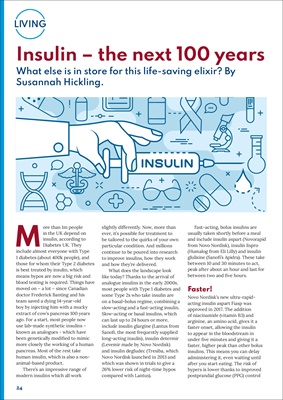
24
LIVING
Insulin - the next 100 years
What else is in store for this life-saving elixir? By
Susannah Hickling.
More than 1m people
in the UK depend on
insulin, according to
Diabetes UK. They
include almost everyone with Type
1 diabetes (about 400k people),
and the rest for whom their Type 2
diabetes is best treated by insulin,
which means hypos are now a big
risk and blood testing is required.
Things have moved on - a lot - since
Canadian doctor Frederick Banting
and his team saved a dying 14-yearold boy
by injecting him with a
mucky extract of cow's pancreas 100
years ago. For a start, most people
now use lab-made synthetic insulins
- known as analogues - which have
been genetically modified to mimic
more closely the working of a human
pancreas. Most of the rest take
human insulin, which is also a nonanimal-based
product.
There's an impressive range of
modern insulins which all work
slightly differently. Now, more than
ever, it's possible for treatment to
be tailored to the quirks of your own
particular condition. And millions
continue to be poured into research
to improve insulins, how they work
and how they're delivered.
What does the landscape look
like today? Thanks to the arrival of
analogue insulins in the early 2000s,
most people with Type 1 diabetes and
some Type 2s who take insulin are
on a basal-bolus regime, combining a
slow-acting and a fast-acting insulin.
Slow-acting or basal insulins, which
can last up to 24 hours or more,
include insulin glargine (Lantus from
Sanofi, the most frequently supplied
long-acting insulin), insulin determir
(Levemir made by Novo Nordisk)
and insulin degludec (Tresiba, which
Novo Nordisk launched in 2013 and
which was shown in trials to give a
26% lower risk of night-time hypos
compared with Lantus).
Fast-acting, bolus insulins are
usually taken shortly before a meal
and include insulin aspart (Novorapid
from Novo Nordisk), insulin lispro
(Humalog from Eli Lilly) and insulin
glulisine (Sanofi's Apidra). These take
between 10 and 30 minutes to act,
peak after about an hour and last for
between two and five hours.
Faster!
Novo Nordisk's new ultra-rapidacting
insulin aspart Fiasp was
approved in 2017. The addition
of niacinamide (vitamin B3) and
arginine, an amino acid, gives it a
faster onset, allowing the insulin
to appear in the bloodstream in
under five minutes and giving it a
faster, higher peak than other bolus
insulins. This means you can delay
administering it, even waiting until
after you start eating. The risk of
hypers is lower thanks to improved
postprandial glucose (PPG) control
but, as with insulin aspart Novorapid,
hypoglycaemia can be a problem.
Newer still and competing with
Fiasp is Lilly's ultra-rapid lispro
(URLi), which goes under the trade
name Lyumjev. It is formulated with
Treprostinil (used to treat pulmonary
hypertension by improving blood
flow) and citrate to improve and
speed up absorption.
There is much research emphasis
on developing faster-acting insulins,
partly because these would be more
ideal for use with a closed-loop
artificial pancreas system. This has
become a serious option for many
Type 1s, thanks to the growing
popularity of non-invasive glucose
monitoring, such as the Freestyle
Libre. Since last April, the NHS has
been piloting closed loop technology